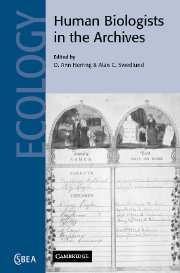 Human Biologists in the Archives
Human Biologists in the Archives Published online by Cambridge University Press: 12 August 2009
Introduction
Katz (1995) suggests that the purpose of poor relief historically was to prevent death from starvation, disease, homelessness, and lack of clothing. Thus the growing number of destitute people in the United States at the beginning of the nineteenth century prompted the establishment of almshouses to provide relief. These institutions were intended to isolate individuals from the corrupting influences of the outside world that were alleged to lead to a life of laziness, alcohol abuse and, ultimately, pauperism (Katz 1983, 1986, 1995). The failure of the almshouse system to provide for its inmates is well documented (Katz 1983, 1986, 1995; Lawrence 1976; Leiby 1978; Rothman 1971). Almshouses were overcrowded with immigrants who spent their last pennies on passage to America, arriving destitute and often sick. Inmates frequently endured appalling living conditions, inadequate food and exposure to infectious diseases. The almshouses in New York State exemplify these deficiencies. Inspections in 1856 indicated that living conditions in many of the State's institutions were ‘ … badly constructed, ill-arranged, ill-warmed and ill-ventilated’ (New York State Senate Report of 1857, in Katz 1986). Mortality records from the Monroe County Almshouse in Rochester, New York, also suggest that these institutions were pesthouses, where many people who were suffering from infectious diseases came to die (Higgins et al. 2002; Higgins and Sirianni 1995; Lanphear 1986; Sirianni and Higgins 1995).
To save this book to your Kindle, first ensure [email protected] is added to your Approved Personal Document E-mail List under your Personal Document Settings on the Manage Your Content and Devices page of your Amazon account. Then enter the ‘name’ part of your Kindle email address below. Find out more about saving to your Kindle.
Note you can select to save to either the @free.kindle.com or @kindle.com variations. ‘@free.kindle.com’ emails are free but can only be saved to your device when it is connected to wi-fi. ‘@kindle.com’ emails can be delivered even when you are not connected to wi-fi, but note that service fees apply.
Find out more about the Kindle Personal Document Service.
To save content items to your account, please confirm that you agree to abide by our usage policies. If this is the first time you use this feature, you will be asked to authorise Cambridge Core to connect with your account. Find out more about saving content to Dropbox.
To save content items to your account, please confirm that you agree to abide by our usage policies. If this is the first time you use this feature, you will be asked to authorise Cambridge Core to connect with your account. Find out more about saving content to Google Drive.